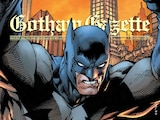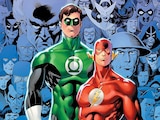Detective. Occultist. Hellblazer. Preteen?
John Constantine has been many things since his debut in 1985, but you’ve never seen him quite like this. The Mystery of the Meanest Teacher: A Johnny Constantine Graphic Novel introduces us to an underage Constantine as the magic-wielding mischief maker comes to the United States to go to boarding school. There he’ll find himself completely out of his depths when he finds himself going head-to-head against a teacher who may be a witch. Getting to the bottom of this magical mystery will take befriending a fellow young magician and obtaining help from a familiar rhyming demon.
Hey, he might be young, but he’s the same old Constantine.
If you’re wondering where the idea of a “Kid Constantine” came from, look to none other than writer Ryan North and artist Derek Charm, the Eisner-winning team behind The Mystery of the Meanest Teacher. They share an easy rapport, having worked together previously on other acclaimed comics featuring courageous young heroes. The two sat down with DCComics.com earlier this week to chat about reenvisioning John Constantine, whether dinosaurs are even more frightening when they’re ghosts and how to make things scary…but not too scary.

Let’s talk about Kid Constantine! Er, Constantine? A certain demon in the book rhymes it with “kind.” Is that the official pronunciation?
Ryan North: So, Derek and I have discussed this and we haven’t quite figured out which is correct. I asked Twitter and I got two people sending me images of comics with different versions of it. (laughs) So I feel like there are no wrong answers here. My impression is that Constantine is the more correct one, so that’s why Etrigan rhymes with it in the book.
I’m not going to correct anyone for saying “Constan-teen,” but Constantine might!
Derek Charm: That rhyme is what I brought up to Ryan when we were discussing it. “Well, it was in the book as tine…”
Ryan: But he’s younger, so “teen,” there’s a pun there!
Yes! So, Constantine isn’t a character you would typically look at and say, there’s a kids’ book. How did the book get started with John Constantine as a starring character?
Ryan: It started when we were trying to do a different book and it wasn’t quite coming together. DC said, “How do you feel about Kid Constantine?” I was very unprofessional and laughed out loud. He is probably DC’s most adult character, one you’d think would be most resistant to being adapted to a middle grade context.

Once you laugh at the joy of the idea, you start thinking, how can we actually do this? How could that work? I realized that Constantine is a guy who is usually in over his head and trying to fake that he has more of an idea of what’s going on than he actually does. That is a first day of school experience right there. There’s not a long walk between two characters in that emotional state. That felt, for me, like something that was natural.
That’s where I started with the character. I know that Derek had a much harder job, because he had to imagine what these characters would look like and make a 13-year-old look credible as a young John Constantine and also credible as a child who would wear these clothes.
Derek: That’s how I thought of it. It’s not necessarily Constantine as a child. It’s if he was a child, how to adapt his adult clothes in a way that makes sense for a kid. If you didn’t know who this character was, you wouldn’t think it was weird or a kid in a costume of an adult.
Was the amazing “Heckblazer” t-shirt your idea?
Derek: It was something we were joking about with our editor, Jim Chadwick. We were just emailing about it and it was our editor who said, “You should put it on a t-shirt.” I didn’t think I would be allowed to! Once he said that, I also put Johnny in a Batman shirt in one scene, just trying anything until they said no.

Since this is a kids’ book, how do you approach making things like demons, ghosts and witches scary but not too scary for young readers?
Ryan: I feel like I had the easy job because they’re already scary. They’re powerful, unpredictable figures and that’s a kid’s experience of the world around you.
My concern was always, I don’t want to make these too terrifying. In the book, there’s a part where there’s a portal to an underworld. If you were doing this in an adult book, you would really describe the precise nature of that red, flaming underworld. (laughs) But in a kids’ book, it’s just filled with these demons. As soon as I saw Derek’s demon design, I kept wishing there were more demons in the book because they were so funny. They’re scary, but they’re an accessible scary. That was a really neat trick to pull off.
Derek: I knew there was a line we couldn’t go past as far as the horror elements for it. I tried to make the demons and witches a little funny but still scary. I was doing something like caricatures of demons from medieval paintings. They had a bird face, or cats on their hands, which one of our demons has—
Ryan: They do?!
Derek: I’d find a way to make a funny version of those horrible paintings.
Ryan: That’s great.

I thought maybe the ghost dinosaurs were another way to make things less scary…and that perhaps Ryan had something to do with those.
Ryan: Yes, I did specify people riding dinosaur ghosts. A little author trademark there!
I have a question for Derek, if you don’t mind.
Go for it.
Ryan: Derek, what was your favorite and least favorite sequence to draw from the script?
Derek: Oh, wow. I think my favorite was the beginning of the book with the ghosts and demons. I actually really did love drawing those demons because their relationship with Constantine in those beginning scenes is so fun, and the way it was written, you knew these characters right away.
Hmm, least favorite… I don’t know, any scene where we’re in a classroom with desks in perspective. (laughs) The first few times I was fine and then—it was a challenge. More so than drawing scary demons.

Ryan: I mean, there are extended sequences where they’re at a desk.
Derek: Oh, I know.
Ryan: (laughs)
Derek, did you have any specific inspiration for the Big Bad at the end of the book? I got a little bit of a Scooby-Doo villain feeling from her.
Derek: They had scary monsters in Scooby-Doo too, but not too scary, and that’s kind of what I was thinking. I just wanted her to keep becoming scarier and scarier as it went on. And we have Etrigan the Demon in the book. He has a batlike face, so I gave her the same nose and the same sort of structure he has.
I also wanted to ask about Constantine’s parents. I liked that they were actually in the book and nothing horrible happened to them. Did you put a lot of thought into what his parents would be like?
Ryan: It was more of a structural thing. Part of the reason of moving him from the UK to America, beyond getting him off-balance and no longer on his right foot, was to get him out of the range of any sort of parental authority who could step in and say, “What you’re doing is wild and you should just talk to us instead.” Which is always great when you’re writing a younger character.

Normally Constantine does not have parents or that relationship with his parents, but I thought having them there was a clean way to say there’s someone looking out for this kid on some level. He’s tricking them, he’s misleading them, he’s lying to them, but there’s someone who loves and cares for this kid to stop us from worrying too much about him in those first scenes. We’ll worry about him once he’s in deeper trouble.
The advantage of doing a book like this for the DC Kids line is that you’re not tied to the mainstream continuity of these characters. You get to take their cores and play with them. I don’t have to worry that “in this issue from 1986, he didn’t have parents when he was 13 years old,” and now I can’t use them anymore. Sometimes it’s nice to be freed from the demands of continuity.
I mean, his parents are really only there for one scene and they’re being tricked by Constantine. He’s a tricky guy.
Meet these demons and detectives only in The Mystery of the Meanest Teacher: A Johnny Constantine Graphic Novel, now available in bookstores, comic shops, libraries and as a digital graphic novel.
Kelly Knox writes about all-ages comics and animation for DCComics.com and her writing can also be seen on IGN, Nerdist and more. Follow her on Twitter at @kelly_knox to talk superheroes, comics and crafts.















